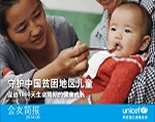-
1/16
In China’s Sichuan Province, where a magnitude 8.0 earthquake caused heavy toll in 2008, the provincial education authority has added Life Safety Education, which includes the component of disaster risk education, to the local curricula. However, the lack of investment is hampering the satisfactory delivery of the course.
©UNICEF/China/2017/Sun Peng
http://www.unicef.cn/en/uploadfile/2018/0713/20180713113937136.jpg

-
2/16
This summer, UNICEF and the National Centre for Educational Technology jointly held two summer camps in Shifang and Beichuan Counties, which were among the regions most affected by the 2008 earthquake. The summer camps are part of the Disaster Risk Reduction (DRR) Model Building Pilot Programme in Western China, jointly supported by UNICEF and several Government agencies.
©UNICEF/China/2017/Sun Peng
http://www.unicef.cn/en/uploadfile/2018/0713/20180713113937191.jpg

-
3/16
The project aims to increase emergency preparedness and resilience in China, prevent the loss of life and minimize the negative social and economic impacts of disasters on vulnerable children, their families and communities. Launched in August 2016, the DRR project is being implemented in seven counties in Sichuan Province, all prone to disasters.
©UNICEF/China/2017/Sun Peng
http://www.unicef.cn/en/uploadfile/2018/0713/20180713113938503.jpg

-
4/16
Around 90 children aged from 9 to 12 and 30 teachers participated in each four-day summer camp.
©UNICEF/China/2017/Sun Peng
http://www.unicef.cn/en/uploadfile/2018/0713/20180713113939131.jpg

-
5/16
Children at the summer camp practise the knowledge and skills they learned about self-protection in the face of disasters through real-life simulations.
©UNICEF/China/2017/Sun Peng
http://www.unicef.cn/en/uploadfile/2018/0713/20180713113939325.jpg

-
6/16
Children from the summer camp file into the Sichuan Disaster Prevention and Reduction Museum in Chengdu City, where they learned some basic knowledge about disasters and how to protect themselves in various disaster scenarios such as earthquakes, landslides and floods, as well as first-aid techniques, through participating in engaging activities.
©UNICEF/China/2017/Sun Peng
http://www.unicef.cn/en/uploadfile/2018/0713/20180713113940807.jpg

-
7/16
Two girls learn how a landslide is formed at the museum in Chengdu.
©UNICEF/China/2017/Sun Peng
http://www.unicef.cn/en/uploadfile/2018/0713/20180713113940348.jpg

-
8/16
A museum guide shows the children why and how an earthquake occurs.
©UNICEF/China/2017/Sun Peng
http://www.unicef.cn/en/uploadfile/2018/0713/20180713113940691.jpg

-
9/16
Inside an earthquake simulator, the children get a safe, yet realistic experience of the intense shaking that can occur during an earthquake. Under the direction of a museum guide, they crouch down and cover their heads with their arms.
©UNICEF/China/2017/Sun Peng
http://www.unicef.cn/en/uploadfile/2018/0713/20180713113941753.jpg

-
10/16
Children pile up blocks on a seismic simulator to learn about primary waves, secondary waves and surface waves. They found out through several experiments that surface waves cause the most severe destruction.
©UNICEF/China/2017/Sun Peng
http://www.unicef.cn/en/uploadfile/2018/0713/20180713113941545.jpg

-
11/16
Back at the camp, two girls, each given a compass and a map, learn orienteering skills.
©UNICEF/China/2017/Sun Peng
http://www.unicef.cn/en/uploadfile/2018/0713/20180713113942396.jpg

-
12/16
Children look at maps as they try out the orienteering skills they just learned.
©UNICEF/China/2017/Sun Peng
http://www.unicef.cn/en/uploadfile/2018/0713/20180713113942665.jpg

-
13/16
With the help of a teacher, a girl learns to extinguish a fire with a fire extinguisher, during a fire drill part of the summer camp.
©UNICEF/China/2017/Sun Peng
http://www.unicef.cn/en/uploadfile/2018/0713/20180713113942285.jpg

-
14/16
Guided by Professor Yang Saini from Beijing Normal University, the children and teachers, who were divided into groups, map out risks in their community and develop emergency plans through lively discussions and debates.
©UNICEF/China/2017/Sun Peng
http://www.unicef.cn/en/uploadfile/2018/0713/20180713113943858.jpg

-
15/16
A group of boys engage in the mapping exercise. All the children had a chance to get involved in the process and then present the results to the class.
©UNICEF/China/2017/Sun Peng
http://www.unicef.cn/en/uploadfile/2018/0713/20180713113943448.jpg

-
16/16
“Though all the schools now have disaster risk education in their curricula, it has very limited impact as it is all about rote learning. We hope that through this participatory approach, these children can embrace the idea of disaster risk and gain some problem-solving skills while teachers could be inspired to change their teaching methods, and when they go back to school, they can pass on what they learned to more students and teachers,” says Professor Yang. “More importantly, through the pilot activities, we aim to develop a set of participatory and exploratory approaches to make disaster risk education more lively and engaging, so that more children will benefit from it.”
©UNICEF/China/2017/Sun Peng
http://www.unicef.cn/en/uploadfile/2018/0713/20180713113944479.jpg










































